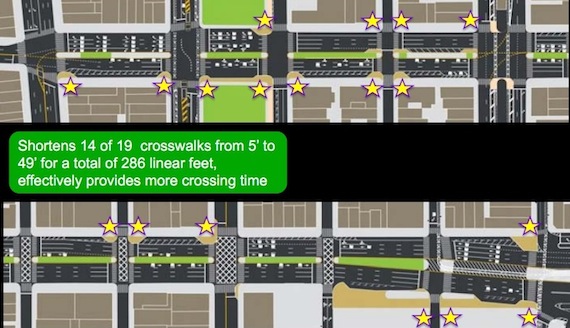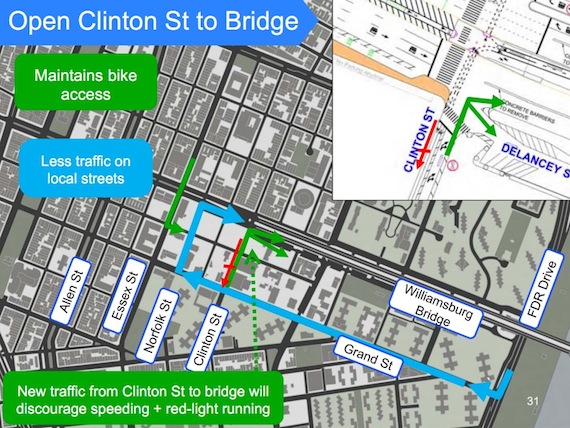
The crosswalks will be getting shorter on Delancey Street -- one of the city's deadliest corridors -- thanks to a new safety plan from the Department of Transportation [PDF]. At 14 of 19 crossings between Clinton Street and the Bowery, neckdowns will extend the sidewalk into the street, making the distance across the extremely wide street a bit more manageable. While DOT found ways to add pedestrian space where it could, however, the department rejected options, some of which were very popular, that would interfere with the heavy traffic headed to and from the Williamsburg Bridge.
The changes to Delancey focus on the dangerous blocks approaching the Williamsburg Bridge. Cyclist Jeffrey Axelrod and pedestrians Patricia Cuevas and Dashane Santana were killed by drivers along these blocks in the last year alone. Over a five year period, 129 people were injured in traffic crashes at both Delancey and Essex and Delancey and Clinton.
The most extensive changes will come at Delancey and Clinton, the intersection right by the bridge entrance. Right now, the distance across Delancey is an incredible 165 feet, including a 30 foot median. "It begins to look more like a highway than a normal street," said DOT bicycle and pedestrian director Josh Benson. "It gives a perception to motorists that they've entered a new environment, that it's not a neighborhood street anymore."
On the north side of Delancey, the sidewalk will be extended into the street a full 49 feet using paint and planters. The first lane coming off the bridge is a right-turn only lane, and there's no reason for the space directly in front of it to remain open to traffic. "What we can do is capture that space, formalize it, and make it safe for people to walk to that place in the crosswalk," said Benson.
Across the street, the service road for Delancey will be filled in and turned into pedestrian space: 14,160 square feet between Norfolk and Clinton.
On the other end of the corridor, at Bowery, another large neckdown will be installed at the southern end of the intersection. As Kenmare becomes Delancey at that intersection, each half of the street abruptly widens from two lanes to four. That means there's a lot of extra road space, some of which is being reclaimed for pedestrians. The road will now widen to four lanes more gradually.

DOT also plans to allow drivers to turn onto the bridge from Clinton Street, which will be turned into a one-way northbound street between Grand and Delancey. The goal, said Benson, is to reduce the number of blocks drivers travel through the neighborhood when they go from the FDR Drive to the Williamsburg Bridge. Additionally, the presence of turning cars at Clinton Street might make eastbound Delancey drivers honor that red light more than they do currently. Bike access on Clinton would be maintained with a two-way bike lane.
Three new left turn restrictions would reduce turning conflicts where Delancey intersects with Chrystie, Allen, and Essex. Half of all pedestrians hit on Delancey Street are struck while they have the walk signal, according to Benson.
The improvements will be in place by June, when construction work ends on the bridge and a permanent traffic pattern is back in place.
Generally, the improvements earned commendations from local residents.
"This is more than I actually expected and I'm very pleased about it," said CB 3 transportation committee chair David Crane. The improvements also won support from the Delancey Street Safety Working Group, made up of State Senator Daniel Squadron, Assembly Speaker Sheldon Silver, Council Member Margaret Chin, Congresswoman Nydia Velazquez, Manhattan Borough President Scott Stringer, Assemblymember Brian Kavanagh, and Council Member Rosie Mendez.
Many, however, wanted to see additional safety improvements that DOT was unwilling to make. "We continue to feel that the lights to cross Delancey need to be lengthened," said April Lewis, a member of the community organization Manhattan Together.
Benson, however, said that while DOT is studying retiming the signals, no major changes are in the works, lest Williamsburg Bridge traffic be negatively affected. "There might be a second here, a second there," he said. "Making a radical shift in that could have some pretty significant impacts on traffic flow."
"You are talking about, basically, appeasements," responded one man standing at the back of the room. "The philosophy would be cars over people."
Similarly, many community members complained that the traffic enforcement agents stationed at the foot of the Williamsburg Bridge wave through traffic without the slightest regard for pedestrians or walk lights. When the agents are stationed there, said Crane, "there effectively is zero pedestrian crossing time."
Also off the table was any reduction in space for traffic on or off the bridge. DOT won't change the core width of Delancey Street while all that bridge traffic is pouring over it. For now, one can only wonder what the agency might have been willing to do had congestion pricing passed Sheldon Silver's Assembly in 2008, or if the Fare Hike Four hadn't killed bridge tolls in the State Senate in 2009.
The Delancey Street Safety Working Group will continue to meet, however, so more safety improvements could be added at a later date. "It is rare to get a government agency to move so aggressively and so quickly, and also to do it hand in hand with the community," said Squadron, who added that more needs to be done. After the meeting, he mentioned bicycle safety and the quality of the median as two potential areas for improvement. "This is not the end of this," he said.





